Strategy Evaluation: Tesco's Effectiveness in Achieving Objectives
VerifiedAdded on 2022/12/28
|13
|3909
|62
AI Summary
This report evaluates the effectiveness of Tesco's strategy in achieving its objectives in the retail industry. It analyzes the company's mission and vision statements, objectives, and strategy evaluation using the VRIO framework. It also examines the external environment using the PESTLE framework and applies Porter's Five Forces to assess Tesco's attractiveness. The report provides insights into Tesco's competitive advantage and recommendations for improvement.
Contribute Materials
Your contribution can guide someone’s learning journey. Share your
documents today.
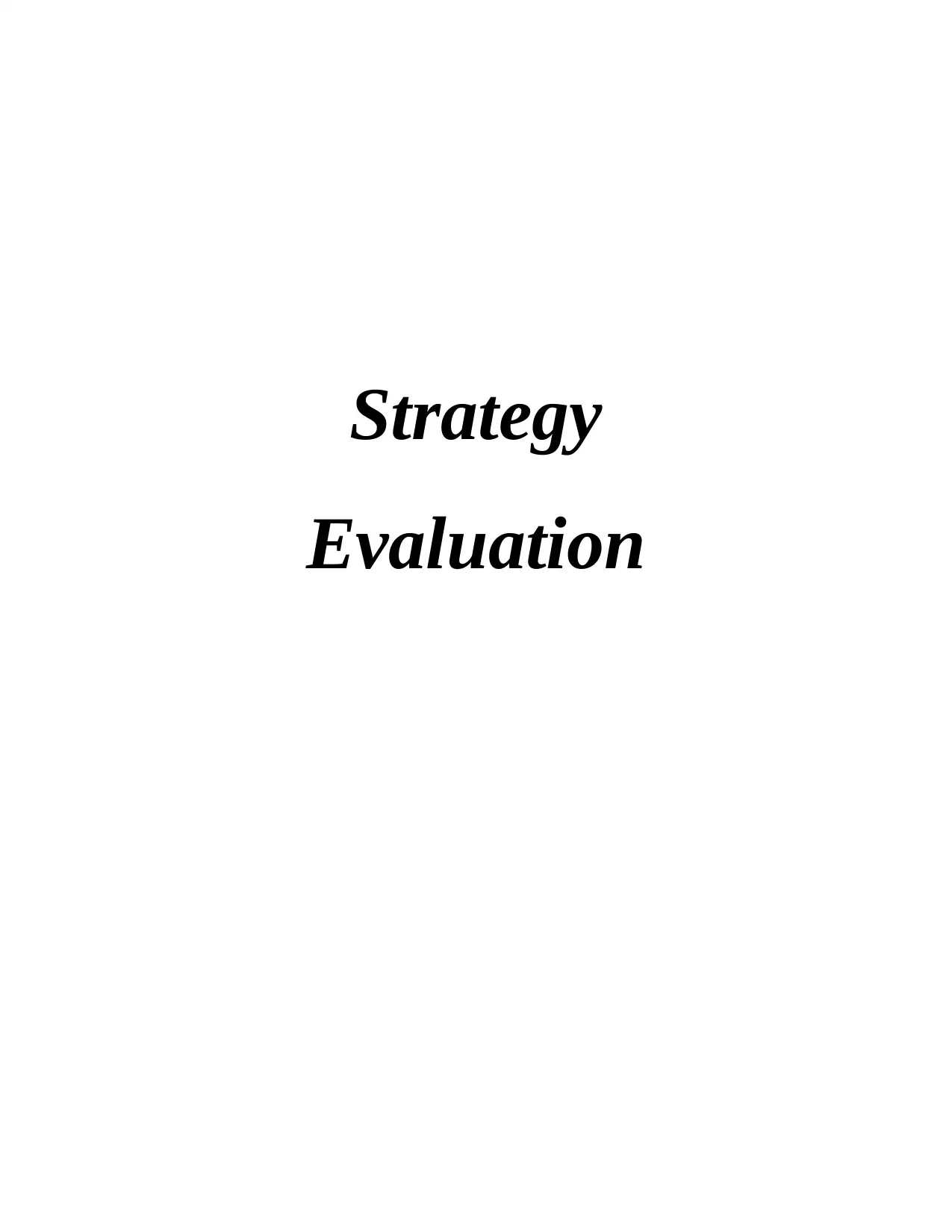
Strategy
Evaluation
Evaluation
Secure Best Marks with AI Grader
Need help grading? Try our AI Grader for instant feedback on your assignments.
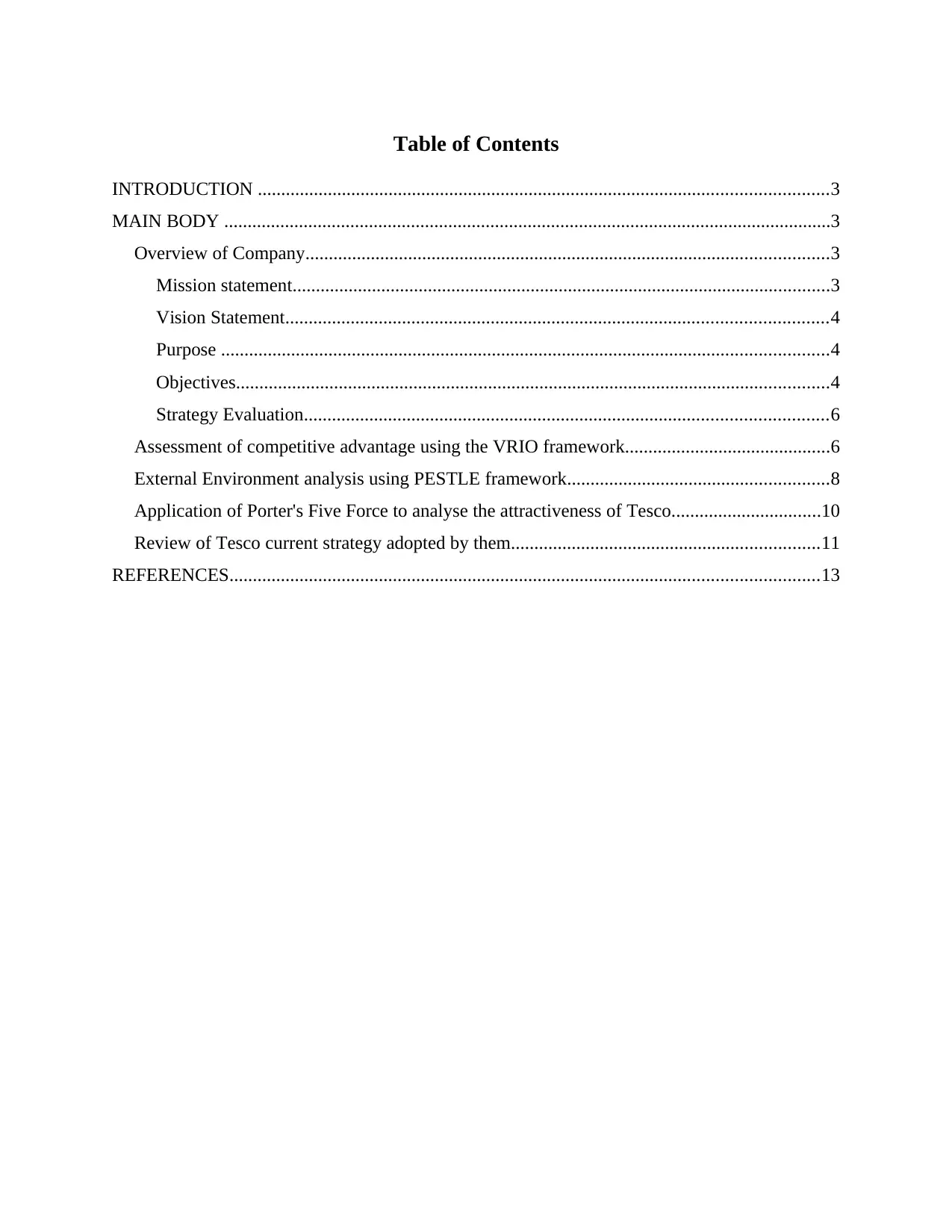
Table of Contents
INTRODUCTION ..........................................................................................................................3
MAIN BODY ..................................................................................................................................3
Overview of Company................................................................................................................3
Mission statement...................................................................................................................3
Vision Statement....................................................................................................................4
Purpose ..................................................................................................................................4
Objectives...............................................................................................................................4
Strategy Evaluation................................................................................................................6
Assessment of competitive advantage using the VRIO framework............................................6
External Environment analysis using PESTLE framework........................................................8
Application of Porter's Five Force to analyse the attractiveness of Tesco................................10
Review of Tesco current strategy adopted by them..................................................................11
REFERENCES..............................................................................................................................13
INTRODUCTION ..........................................................................................................................3
MAIN BODY ..................................................................................................................................3
Overview of Company................................................................................................................3
Mission statement...................................................................................................................3
Vision Statement....................................................................................................................4
Purpose ..................................................................................................................................4
Objectives...............................................................................................................................4
Strategy Evaluation................................................................................................................6
Assessment of competitive advantage using the VRIO framework............................................6
External Environment analysis using PESTLE framework........................................................8
Application of Porter's Five Force to analyse the attractiveness of Tesco................................10
Review of Tesco current strategy adopted by them..................................................................11
REFERENCES..............................................................................................................................13

INTRODUCTION
Strategy Evaluation refers to evaluating the effectiveness of organisation's current
strategy being followed in achieving their goals and objectives. A strategy is effective when it
works according to the allocated and projected use of resources and achievement of performance.
It is the last phase of the strategic management process in which manager assures that the
company is meeting out the stated objectives efficiently. The strategy evaluation operates at two
levels – Strategic control and Operational control (Alani, Khan and Manuel, 2018). The strategic
control is concerned about the alignment between the strategy being adopted with the
environment. At, operational level focus is given to to organisation effectiveness in pursuing the
strategy. The process of strategy evaluation contains setting the benchmark of performance
against which the actual performance is measured and taking corrective action if gap is found
between the planned and actual performance. The aim of this report is to the test the
effectiveness of strategy adopted by retail giants to achieve their objectives in retail industry.
Tesco, is an multinational retailer headquarter in UK offering diverse range of products to satisfy
the varied needs of consumers.
MAIN BODY
Overview of Company
Tesco was founded in 1919, by Jack Cohen having headquarter in England, UK with
subsidiaries operating across globe. Tesco is world's largest retailer of consumer goods offering
diverse range of products ranging food to lifestyle products. It is listed on the London Stock
Exchange with market capitalisation of £63.911 billion, 2019. The Tesco is ninth largest
company measured in terms of market capturing and third largest in terms of total revenue. From
1960's the company has diversified into diverse rage of products ranging from retailing of
groceries, furniture, electronics, financial services etc. products. The company has been
successful in repositioning itself from being downmarket low cost retailer to becoming one of
giant premium retailer choice among consumers.
Mission statement
Tesco mission statement is to make and deliver the products that satisfy the consumer
needs which leads them to live the better life thus, adding to better quality of life.
Strategy Evaluation refers to evaluating the effectiveness of organisation's current
strategy being followed in achieving their goals and objectives. A strategy is effective when it
works according to the allocated and projected use of resources and achievement of performance.
It is the last phase of the strategic management process in which manager assures that the
company is meeting out the stated objectives efficiently. The strategy evaluation operates at two
levels – Strategic control and Operational control (Alani, Khan and Manuel, 2018). The strategic
control is concerned about the alignment between the strategy being adopted with the
environment. At, operational level focus is given to to organisation effectiveness in pursuing the
strategy. The process of strategy evaluation contains setting the benchmark of performance
against which the actual performance is measured and taking corrective action if gap is found
between the planned and actual performance. The aim of this report is to the test the
effectiveness of strategy adopted by retail giants to achieve their objectives in retail industry.
Tesco, is an multinational retailer headquarter in UK offering diverse range of products to satisfy
the varied needs of consumers.
MAIN BODY
Overview of Company
Tesco was founded in 1919, by Jack Cohen having headquarter in England, UK with
subsidiaries operating across globe. Tesco is world's largest retailer of consumer goods offering
diverse range of products ranging food to lifestyle products. It is listed on the London Stock
Exchange with market capitalisation of £63.911 billion, 2019. The Tesco is ninth largest
company measured in terms of market capturing and third largest in terms of total revenue. From
1960's the company has diversified into diverse rage of products ranging from retailing of
groceries, furniture, electronics, financial services etc. products. The company has been
successful in repositioning itself from being downmarket low cost retailer to becoming one of
giant premium retailer choice among consumers.
Mission statement
Tesco mission statement is to make and deliver the products that satisfy the consumer
needs which leads them to live the better life thus, adding to better quality of life.
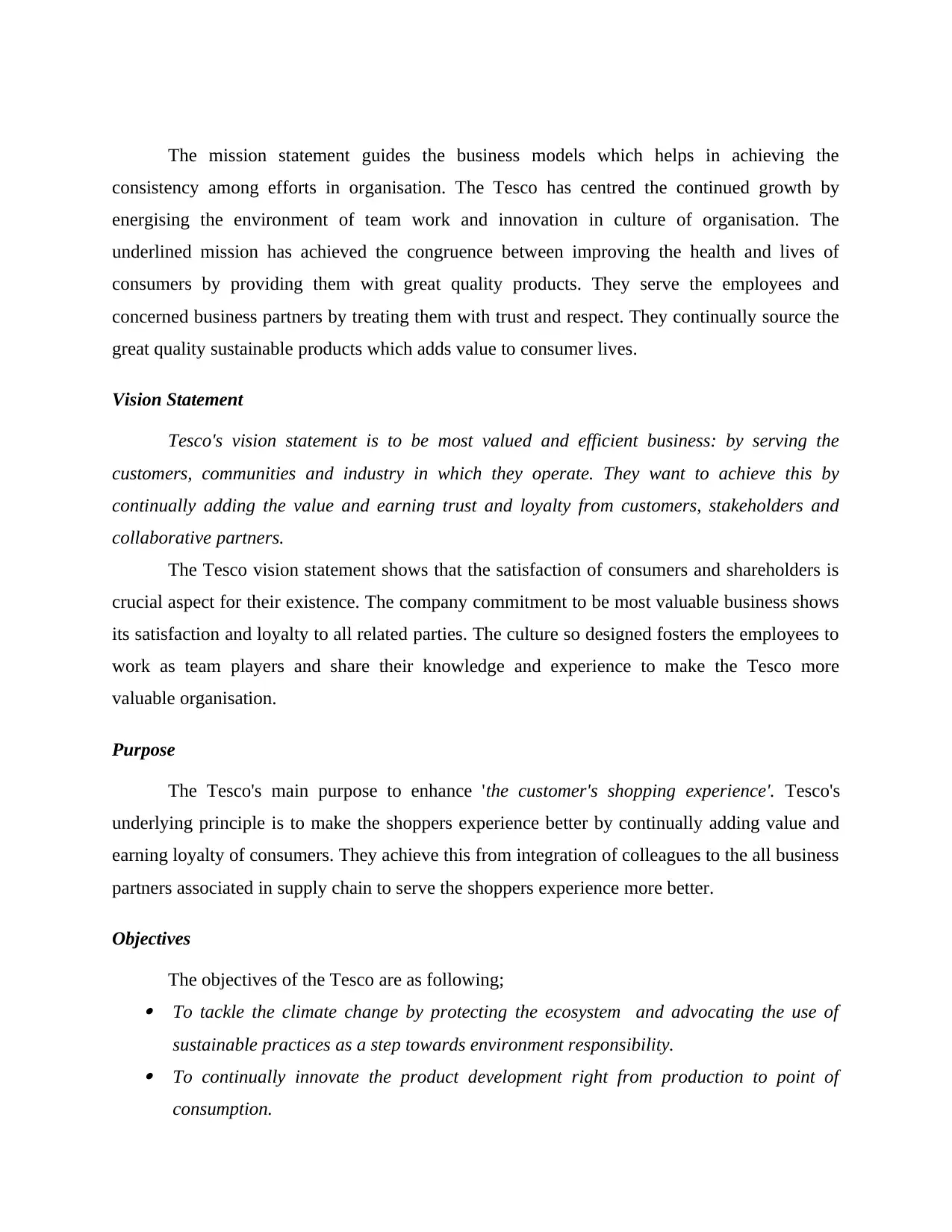
The mission statement guides the business models which helps in achieving the
consistency among efforts in organisation. The Tesco has centred the continued growth by
energising the environment of team work and innovation in culture of organisation. The
underlined mission has achieved the congruence between improving the health and lives of
consumers by providing them with great quality products. They serve the employees and
concerned business partners by treating them with trust and respect. They continually source the
great quality sustainable products which adds value to consumer lives.
Vision Statement
Tesco's vision statement is to be most valued and efficient business: by serving the
customers, communities and industry in which they operate. They want to achieve this by
continually adding the value and earning trust and loyalty from customers, stakeholders and
collaborative partners.
The Tesco vision statement shows that the satisfaction of consumers and shareholders is
crucial aspect for their existence. The company commitment to be most valuable business shows
its satisfaction and loyalty to all related parties. The culture so designed fosters the employees to
work as team players and share their knowledge and experience to make the Tesco more
valuable organisation.
Purpose
The Tesco's main purpose to enhance 'the customer's shopping experience'. Tesco's
underlying principle is to make the shoppers experience better by continually adding value and
earning loyalty of consumers. They achieve this from integration of colleagues to the all business
partners associated in supply chain to serve the shoppers experience more better.
Objectives
The objectives of the Tesco are as following; To tackle the climate change by protecting the ecosystem and advocating the use of
sustainable practices as a step towards environment responsibility. To continually innovate the product development right from production to point of
consumption.
consistency among efforts in organisation. The Tesco has centred the continued growth by
energising the environment of team work and innovation in culture of organisation. The
underlined mission has achieved the congruence between improving the health and lives of
consumers by providing them with great quality products. They serve the employees and
concerned business partners by treating them with trust and respect. They continually source the
great quality sustainable products which adds value to consumer lives.
Vision Statement
Tesco's vision statement is to be most valued and efficient business: by serving the
customers, communities and industry in which they operate. They want to achieve this by
continually adding the value and earning trust and loyalty from customers, stakeholders and
collaborative partners.
The Tesco vision statement shows that the satisfaction of consumers and shareholders is
crucial aspect for their existence. The company commitment to be most valuable business shows
its satisfaction and loyalty to all related parties. The culture so designed fosters the employees to
work as team players and share their knowledge and experience to make the Tesco more
valuable organisation.
Purpose
The Tesco's main purpose to enhance 'the customer's shopping experience'. Tesco's
underlying principle is to make the shoppers experience better by continually adding value and
earning loyalty of consumers. They achieve this from integration of colleagues to the all business
partners associated in supply chain to serve the shoppers experience more better.
Objectives
The objectives of the Tesco are as following; To tackle the climate change by protecting the ecosystem and advocating the use of
sustainable practices as a step towards environment responsibility. To continually innovate the product development right from production to point of
consumption.
Paraphrase This Document
Need a fresh take? Get an instant paraphrase of this document with our AI Paraphraser
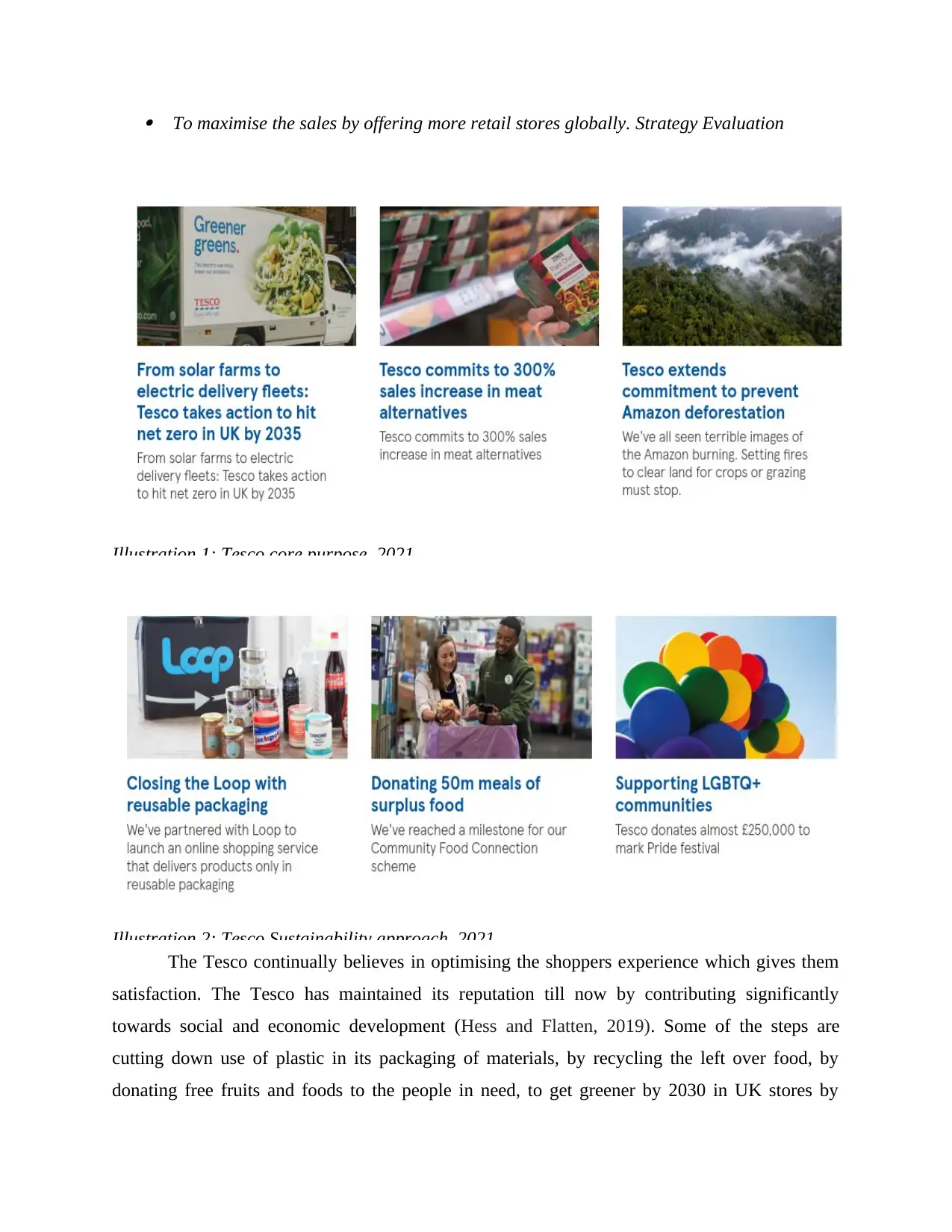
To maximise the sales by offering more retail stores globally. Strategy Evaluation
Illustration 1: Tesco core purpose, 2021
Illustration 2: Tesco Sustainability approach, 2021
The Tesco continually believes in optimising the shoppers experience which gives them
satisfaction. The Tesco has maintained its reputation till now by contributing significantly
towards social and economic development (Hess and Flatten, 2019). Some of the steps are
cutting down use of plastic in its packaging of materials, by recycling the left over food, by
donating free fruits and foods to the people in need, to get greener by 2030 in UK stores by
Illustration 1: Tesco core purpose, 2021
Illustration 2: Tesco Sustainability approach, 2021
The Tesco continually believes in optimising the shoppers experience which gives them
satisfaction. The Tesco has maintained its reputation till now by contributing significantly
towards social and economic development (Hess and Flatten, 2019). Some of the steps are
cutting down use of plastic in its packaging of materials, by recycling the left over food, by
donating free fruits and foods to the people in need, to get greener by 2030 in UK stores by
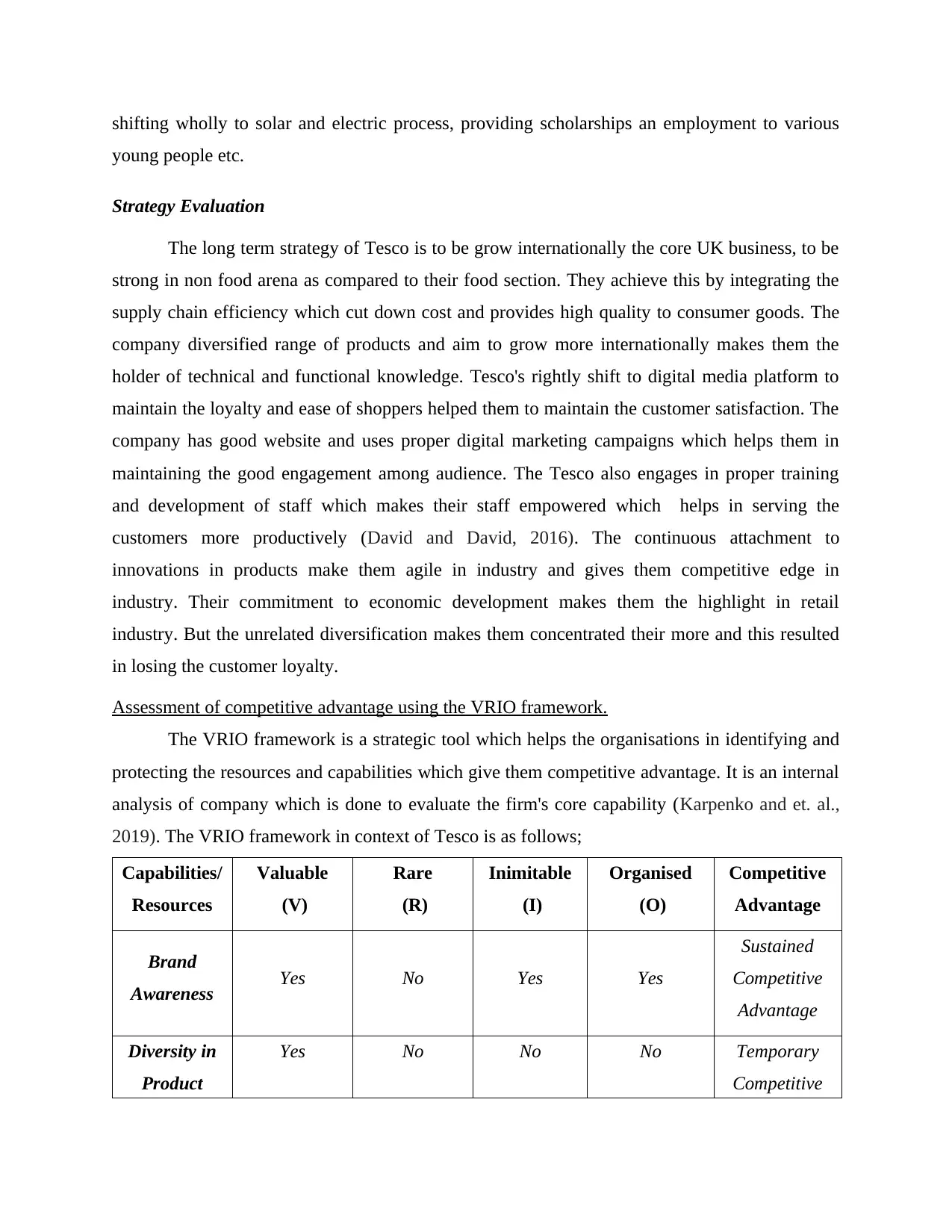
shifting wholly to solar and electric process, providing scholarships an employment to various
young people etc.
Strategy Evaluation
The long term strategy of Tesco is to be grow internationally the core UK business, to be
strong in non food arena as compared to their food section. They achieve this by integrating the
supply chain efficiency which cut down cost and provides high quality to consumer goods. The
company diversified range of products and aim to grow more internationally makes them the
holder of technical and functional knowledge. Tesco's rightly shift to digital media platform to
maintain the loyalty and ease of shoppers helped them to maintain the customer satisfaction. The
company has good website and uses proper digital marketing campaigns which helps them in
maintaining the good engagement among audience. The Tesco also engages in proper training
and development of staff which makes their staff empowered which helps in serving the
customers more productively (David and David, 2016). The continuous attachment to
innovations in products make them agile in industry and gives them competitive edge in
industry. Their commitment to economic development makes them the highlight in retail
industry. But the unrelated diversification makes them concentrated their more and this resulted
in losing the customer loyalty.
Assessment of competitive advantage using the VRIO framework.
The VRIO framework is a strategic tool which helps the organisations in identifying and
protecting the resources and capabilities which give them competitive advantage. It is an internal
analysis of company which is done to evaluate the firm's core capability (Karpenko and et. al.,
2019). The VRIO framework in context of Tesco is as follows;
Capabilities/
Resources
Valuable
(V)
Rare
(R)
Inimitable
(I)
Organised
(O)
Competitive
Advantage
Brand
Awareness Yes No Yes Yes
Sustained
Competitive
Advantage
Diversity in
Product
Yes No No No Temporary
Competitive
young people etc.
Strategy Evaluation
The long term strategy of Tesco is to be grow internationally the core UK business, to be
strong in non food arena as compared to their food section. They achieve this by integrating the
supply chain efficiency which cut down cost and provides high quality to consumer goods. The
company diversified range of products and aim to grow more internationally makes them the
holder of technical and functional knowledge. Tesco's rightly shift to digital media platform to
maintain the loyalty and ease of shoppers helped them to maintain the customer satisfaction. The
company has good website and uses proper digital marketing campaigns which helps them in
maintaining the good engagement among audience. The Tesco also engages in proper training
and development of staff which makes their staff empowered which helps in serving the
customers more productively (David and David, 2016). The continuous attachment to
innovations in products make them agile in industry and gives them competitive edge in
industry. Their commitment to economic development makes them the highlight in retail
industry. But the unrelated diversification makes them concentrated their more and this resulted
in losing the customer loyalty.
Assessment of competitive advantage using the VRIO framework.
The VRIO framework is a strategic tool which helps the organisations in identifying and
protecting the resources and capabilities which give them competitive advantage. It is an internal
analysis of company which is done to evaluate the firm's core capability (Karpenko and et. al.,
2019). The VRIO framework in context of Tesco is as follows;
Capabilities/
Resources
Valuable
(V)
Rare
(R)
Inimitable
(I)
Organised
(O)
Competitive
Advantage
Brand
Awareness Yes No Yes Yes
Sustained
Competitive
Advantage
Diversity in
Product
Yes No No No Temporary
Competitive
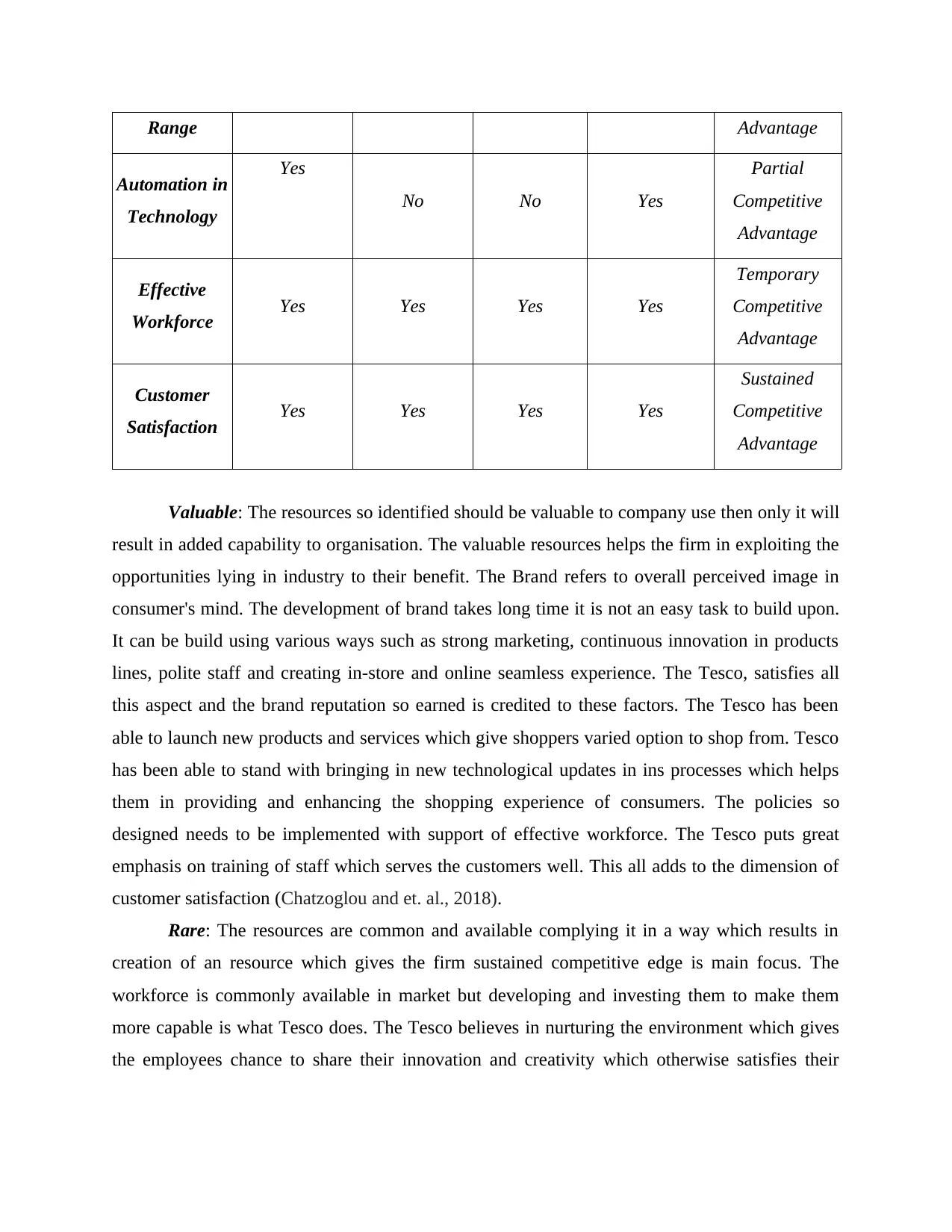
Range Advantage
Automation in
Technology
Yes
No No Yes
Partial
Competitive
Advantage
Effective
Workforce Yes Yes Yes Yes
Temporary
Competitive
Advantage
Customer
Satisfaction Yes Yes Yes Yes
Sustained
Competitive
Advantage
Valuable: The resources so identified should be valuable to company use then only it will
result in added capability to organisation. The valuable resources helps the firm in exploiting the
opportunities lying in industry to their benefit. The Brand refers to overall perceived image in
consumer's mind. The development of brand takes long time it is not an easy task to build upon.
It can be build using various ways such as strong marketing, continuous innovation in products
lines, polite staff and creating in-store and online seamless experience. The Tesco, satisfies all
this aspect and the brand reputation so earned is credited to these factors. The Tesco has been
able to launch new products and services which give shoppers varied option to shop from. Tesco
has been able to stand with bringing in new technological updates in ins processes which helps
them in providing and enhancing the shopping experience of consumers. The policies so
designed needs to be implemented with support of effective workforce. The Tesco puts great
emphasis on training of staff which serves the customers well. This all adds to the dimension of
customer satisfaction (Chatzoglou and et. al., 2018).
Rare: The resources are common and available complying it in a way which results in
creation of an resource which gives the firm sustained competitive edge is main focus. The
workforce is commonly available in market but developing and investing them to make them
more capable is what Tesco does. The Tesco believes in nurturing the environment which gives
the employees chance to share their innovation and creativity which otherwise satisfies their
Automation in
Technology
Yes
No No Yes
Partial
Competitive
Advantage
Effective
Workforce Yes Yes Yes Yes
Temporary
Competitive
Advantage
Customer
Satisfaction Yes Yes Yes Yes
Sustained
Competitive
Advantage
Valuable: The resources so identified should be valuable to company use then only it will
result in added capability to organisation. The valuable resources helps the firm in exploiting the
opportunities lying in industry to their benefit. The Brand refers to overall perceived image in
consumer's mind. The development of brand takes long time it is not an easy task to build upon.
It can be build using various ways such as strong marketing, continuous innovation in products
lines, polite staff and creating in-store and online seamless experience. The Tesco, satisfies all
this aspect and the brand reputation so earned is credited to these factors. The Tesco has been
able to launch new products and services which give shoppers varied option to shop from. Tesco
has been able to stand with bringing in new technological updates in ins processes which helps
them in providing and enhancing the shopping experience of consumers. The policies so
designed needs to be implemented with support of effective workforce. The Tesco puts great
emphasis on training of staff which serves the customers well. This all adds to the dimension of
customer satisfaction (Chatzoglou and et. al., 2018).
Rare: The resources are common and available complying it in a way which results in
creation of an resource which gives the firm sustained competitive edge is main focus. The
workforce is commonly available in market but developing and investing them to make them
more capable is what Tesco does. The Tesco believes in nurturing the environment which gives
the employees chance to share their innovation and creativity which otherwise satisfies their
Secure Best Marks with AI Grader
Need help grading? Try our AI Grader for instant feedback on your assignments.
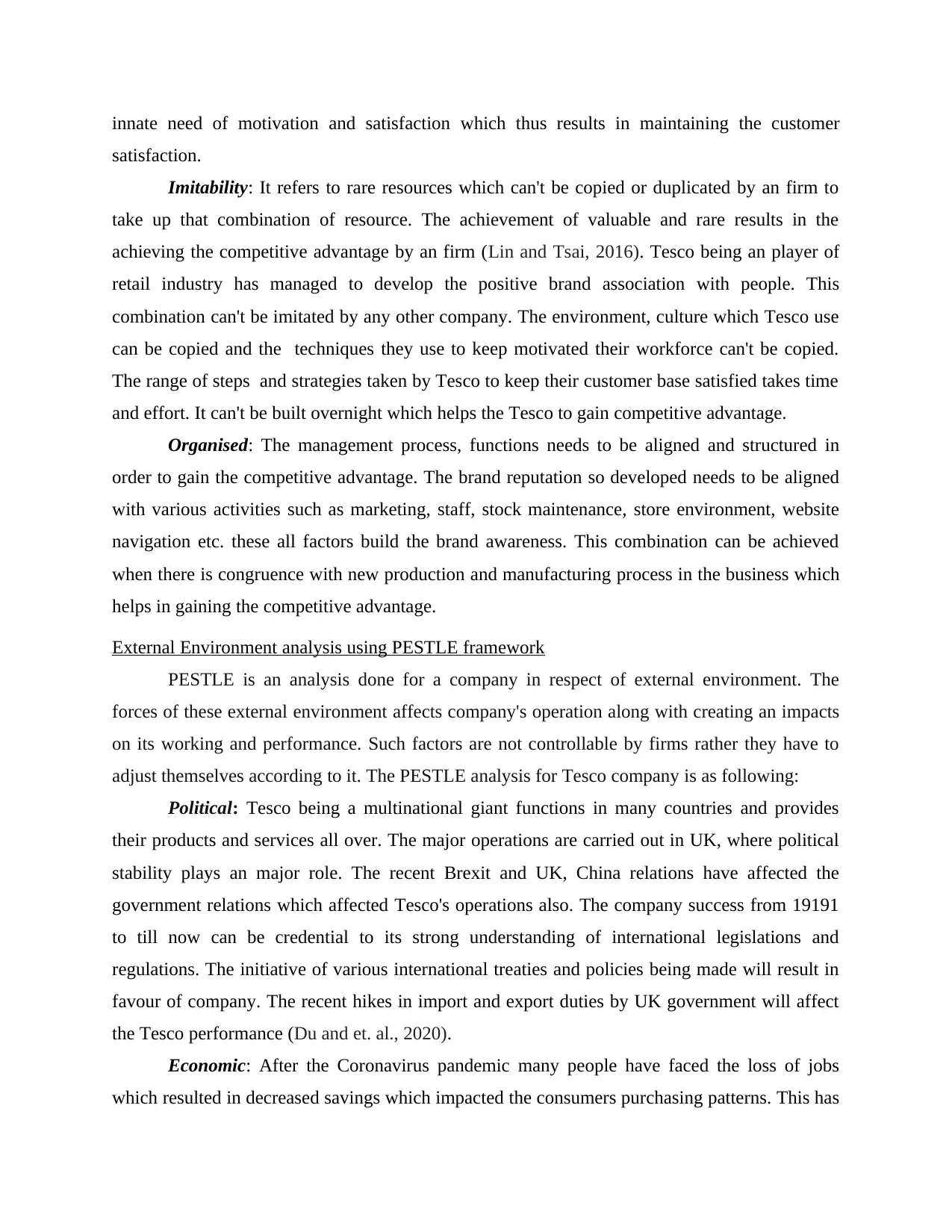
innate need of motivation and satisfaction which thus results in maintaining the customer
satisfaction.
Imitability: It refers to rare resources which can't be copied or duplicated by an firm to
take up that combination of resource. The achievement of valuable and rare results in the
achieving the competitive advantage by an firm (Lin and Tsai, 2016). Tesco being an player of
retail industry has managed to develop the positive brand association with people. This
combination can't be imitated by any other company. The environment, culture which Tesco use
can be copied and the techniques they use to keep motivated their workforce can't be copied.
The range of steps and strategies taken by Tesco to keep their customer base satisfied takes time
and effort. It can't be built overnight which helps the Tesco to gain competitive advantage.
Organised: The management process, functions needs to be aligned and structured in
order to gain the competitive advantage. The brand reputation so developed needs to be aligned
with various activities such as marketing, staff, stock maintenance, store environment, website
navigation etc. these all factors build the brand awareness. This combination can be achieved
when there is congruence with new production and manufacturing process in the business which
helps in gaining the competitive advantage.
External Environment analysis using PESTLE framework
PESTLE is an analysis done for a company in respect of external environment. The
forces of these external environment affects company's operation along with creating an impacts
on its working and performance. Such factors are not controllable by firms rather they have to
adjust themselves according to it. The PESTLE analysis for Tesco company is as following:
Political: Tesco being a multinational giant functions in many countries and provides
their products and services all over. The major operations are carried out in UK, where political
stability plays an major role. The recent Brexit and UK, China relations have affected the
government relations which affected Tesco's operations also. The company success from 19191
to till now can be credential to its strong understanding of international legislations and
regulations. The initiative of various international treaties and policies being made will result in
favour of company. The recent hikes in import and export duties by UK government will affect
the Tesco performance (Du and et. al., 2020).
Economic: After the Coronavirus pandemic many people have faced the loss of jobs
which resulted in decreased savings which impacted the consumers purchasing patterns. This has
satisfaction.
Imitability: It refers to rare resources which can't be copied or duplicated by an firm to
take up that combination of resource. The achievement of valuable and rare results in the
achieving the competitive advantage by an firm (Lin and Tsai, 2016). Tesco being an player of
retail industry has managed to develop the positive brand association with people. This
combination can't be imitated by any other company. The environment, culture which Tesco use
can be copied and the techniques they use to keep motivated their workforce can't be copied.
The range of steps and strategies taken by Tesco to keep their customer base satisfied takes time
and effort. It can't be built overnight which helps the Tesco to gain competitive advantage.
Organised: The management process, functions needs to be aligned and structured in
order to gain the competitive advantage. The brand reputation so developed needs to be aligned
with various activities such as marketing, staff, stock maintenance, store environment, website
navigation etc. these all factors build the brand awareness. This combination can be achieved
when there is congruence with new production and manufacturing process in the business which
helps in gaining the competitive advantage.
External Environment analysis using PESTLE framework
PESTLE is an analysis done for a company in respect of external environment. The
forces of these external environment affects company's operation along with creating an impacts
on its working and performance. Such factors are not controllable by firms rather they have to
adjust themselves according to it. The PESTLE analysis for Tesco company is as following:
Political: Tesco being a multinational giant functions in many countries and provides
their products and services all over. The major operations are carried out in UK, where political
stability plays an major role. The recent Brexit and UK, China relations have affected the
government relations which affected Tesco's operations also. The company success from 19191
to till now can be credential to its strong understanding of international legislations and
regulations. The initiative of various international treaties and policies being made will result in
favour of company. The recent hikes in import and export duties by UK government will affect
the Tesco performance (Du and et. al., 2020).
Economic: After the Coronavirus pandemic many people have faced the loss of jobs
which resulted in decreased savings which impacted the consumers purchasing patterns. This has
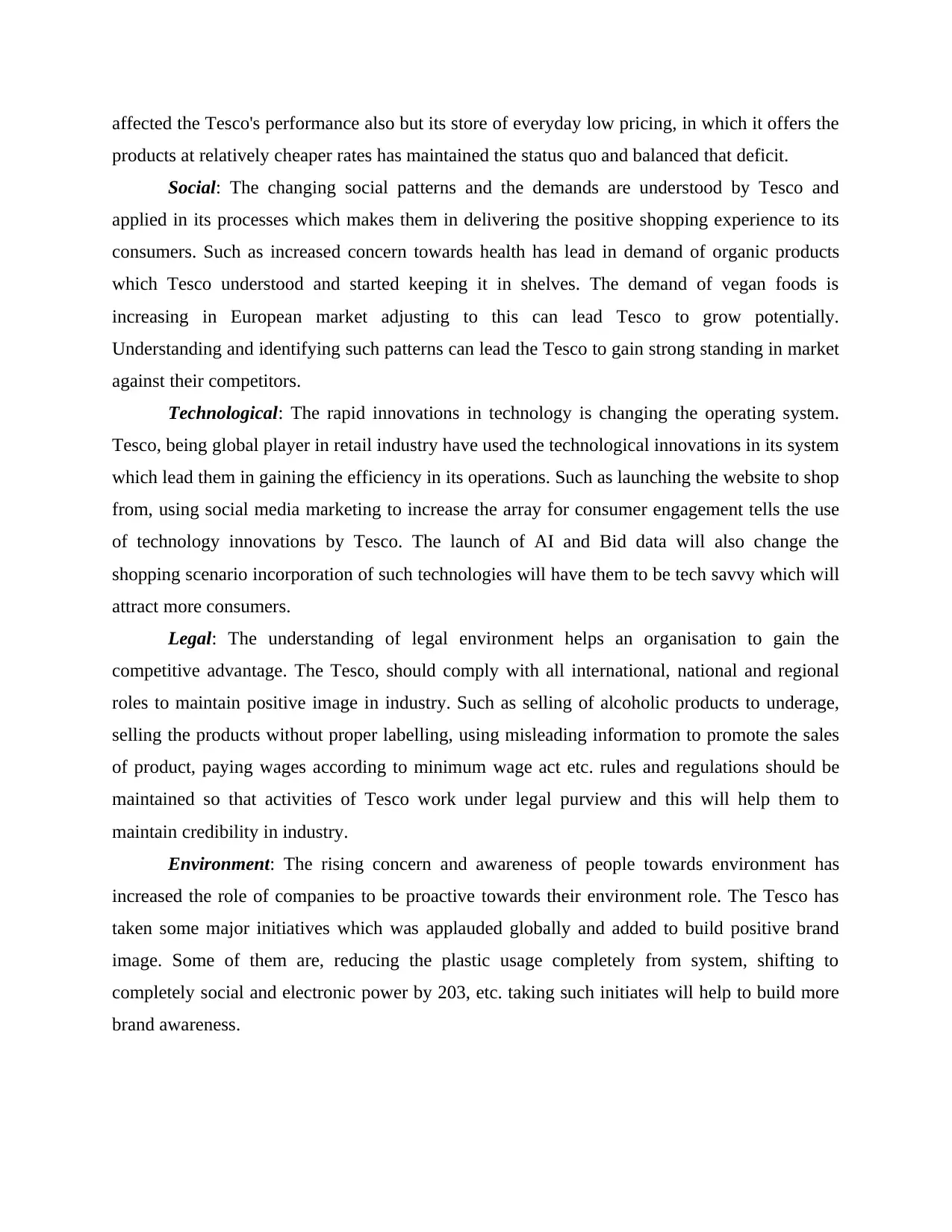
affected the Tesco's performance also but its store of everyday low pricing, in which it offers the
products at relatively cheaper rates has maintained the status quo and balanced that deficit.
Social: The changing social patterns and the demands are understood by Tesco and
applied in its processes which makes them in delivering the positive shopping experience to its
consumers. Such as increased concern towards health has lead in demand of organic products
which Tesco understood and started keeping it in shelves. The demand of vegan foods is
increasing in European market adjusting to this can lead Tesco to grow potentially.
Understanding and identifying such patterns can lead the Tesco to gain strong standing in market
against their competitors.
Technological: The rapid innovations in technology is changing the operating system.
Tesco, being global player in retail industry have used the technological innovations in its system
which lead them in gaining the efficiency in its operations. Such as launching the website to shop
from, using social media marketing to increase the array for consumer engagement tells the use
of technology innovations by Tesco. The launch of AI and Bid data will also change the
shopping scenario incorporation of such technologies will have them to be tech savvy which will
attract more consumers.
Legal: The understanding of legal environment helps an organisation to gain the
competitive advantage. The Tesco, should comply with all international, national and regional
roles to maintain positive image in industry. Such as selling of alcoholic products to underage,
selling the products without proper labelling, using misleading information to promote the sales
of product, paying wages according to minimum wage act etc. rules and regulations should be
maintained so that activities of Tesco work under legal purview and this will help them to
maintain credibility in industry.
Environment: The rising concern and awareness of people towards environment has
increased the role of companies to be proactive towards their environment role. The Tesco has
taken some major initiatives which was applauded globally and added to build positive brand
image. Some of them are, reducing the plastic usage completely from system, shifting to
completely social and electronic power by 203, etc. taking such initiates will help to build more
brand awareness.
products at relatively cheaper rates has maintained the status quo and balanced that deficit.
Social: The changing social patterns and the demands are understood by Tesco and
applied in its processes which makes them in delivering the positive shopping experience to its
consumers. Such as increased concern towards health has lead in demand of organic products
which Tesco understood and started keeping it in shelves. The demand of vegan foods is
increasing in European market adjusting to this can lead Tesco to grow potentially.
Understanding and identifying such patterns can lead the Tesco to gain strong standing in market
against their competitors.
Technological: The rapid innovations in technology is changing the operating system.
Tesco, being global player in retail industry have used the technological innovations in its system
which lead them in gaining the efficiency in its operations. Such as launching the website to shop
from, using social media marketing to increase the array for consumer engagement tells the use
of technology innovations by Tesco. The launch of AI and Bid data will also change the
shopping scenario incorporation of such technologies will have them to be tech savvy which will
attract more consumers.
Legal: The understanding of legal environment helps an organisation to gain the
competitive advantage. The Tesco, should comply with all international, national and regional
roles to maintain positive image in industry. Such as selling of alcoholic products to underage,
selling the products without proper labelling, using misleading information to promote the sales
of product, paying wages according to minimum wage act etc. rules and regulations should be
maintained so that activities of Tesco work under legal purview and this will help them to
maintain credibility in industry.
Environment: The rising concern and awareness of people towards environment has
increased the role of companies to be proactive towards their environment role. The Tesco has
taken some major initiatives which was applauded globally and added to build positive brand
image. Some of them are, reducing the plastic usage completely from system, shifting to
completely social and electronic power by 203, etc. taking such initiates will help to build more
brand awareness.
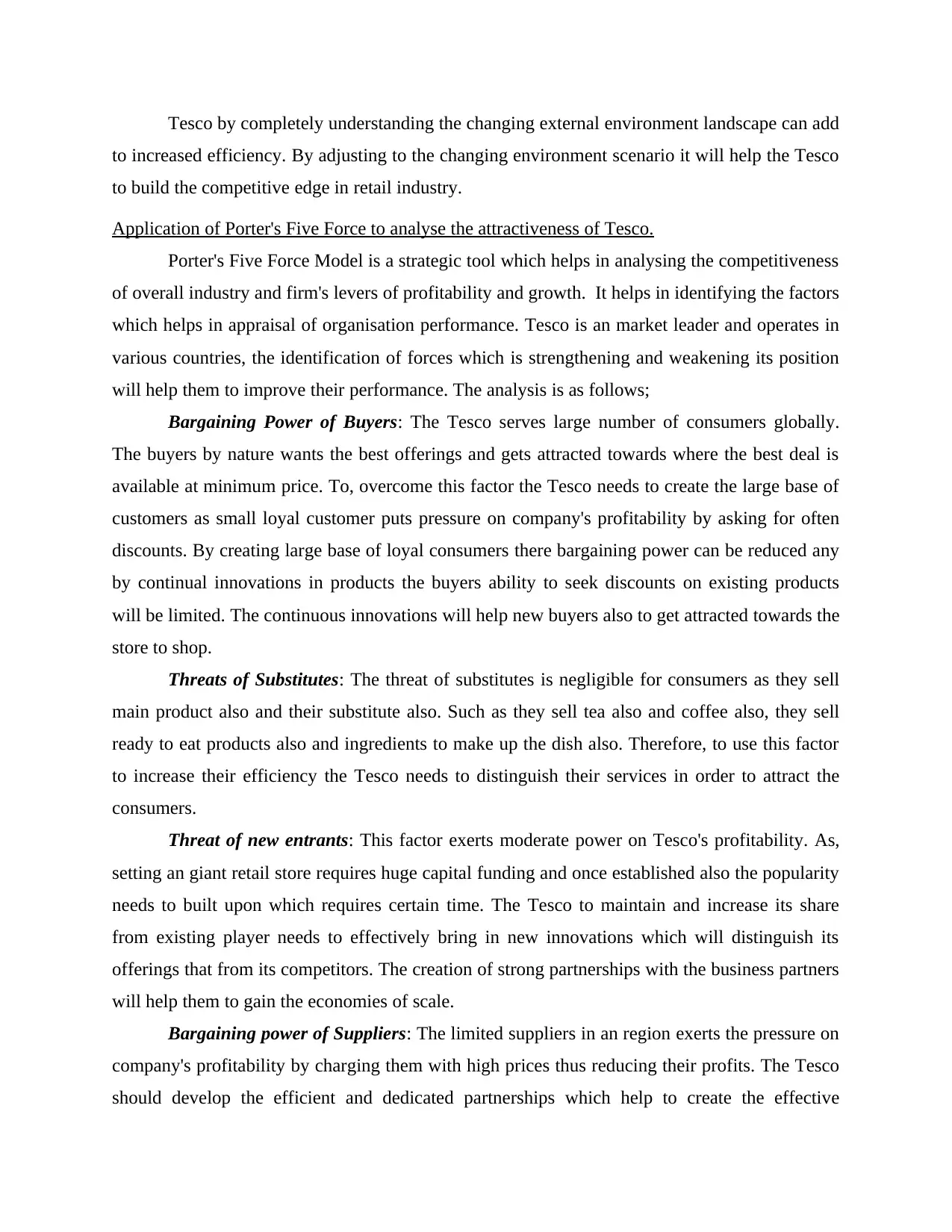
Tesco by completely understanding the changing external environment landscape can add
to increased efficiency. By adjusting to the changing environment scenario it will help the Tesco
to build the competitive edge in retail industry.
Application of Porter's Five Force to analyse the attractiveness of Tesco.
Porter's Five Force Model is a strategic tool which helps in analysing the competitiveness
of overall industry and firm's levers of profitability and growth. It helps in identifying the factors
which helps in appraisal of organisation performance. Tesco is an market leader and operates in
various countries, the identification of forces which is strengthening and weakening its position
will help them to improve their performance. The analysis is as follows;
Bargaining Power of Buyers: The Tesco serves large number of consumers globally.
The buyers by nature wants the best offerings and gets attracted towards where the best deal is
available at minimum price. To, overcome this factor the Tesco needs to create the large base of
customers as small loyal customer puts pressure on company's profitability by asking for often
discounts. By creating large base of loyal consumers there bargaining power can be reduced any
by continual innovations in products the buyers ability to seek discounts on existing products
will be limited. The continuous innovations will help new buyers also to get attracted towards the
store to shop.
Threats of Substitutes: The threat of substitutes is negligible for consumers as they sell
main product also and their substitute also. Such as they sell tea also and coffee also, they sell
ready to eat products also and ingredients to make up the dish also. Therefore, to use this factor
to increase their efficiency the Tesco needs to distinguish their services in order to attract the
consumers.
Threat of new entrants: This factor exerts moderate power on Tesco's profitability. As,
setting an giant retail store requires huge capital funding and once established also the popularity
needs to built upon which requires certain time. The Tesco to maintain and increase its share
from existing player needs to effectively bring in new innovations which will distinguish its
offerings that from its competitors. The creation of strong partnerships with the business partners
will help them to gain the economies of scale.
Bargaining power of Suppliers: The limited suppliers in an region exerts the pressure on
company's profitability by charging them with high prices thus reducing their profits. The Tesco
should develop the efficient and dedicated partnerships which help to create the effective
to increased efficiency. By adjusting to the changing environment scenario it will help the Tesco
to build the competitive edge in retail industry.
Application of Porter's Five Force to analyse the attractiveness of Tesco.
Porter's Five Force Model is a strategic tool which helps in analysing the competitiveness
of overall industry and firm's levers of profitability and growth. It helps in identifying the factors
which helps in appraisal of organisation performance. Tesco is an market leader and operates in
various countries, the identification of forces which is strengthening and weakening its position
will help them to improve their performance. The analysis is as follows;
Bargaining Power of Buyers: The Tesco serves large number of consumers globally.
The buyers by nature wants the best offerings and gets attracted towards where the best deal is
available at minimum price. To, overcome this factor the Tesco needs to create the large base of
customers as small loyal customer puts pressure on company's profitability by asking for often
discounts. By creating large base of loyal consumers there bargaining power can be reduced any
by continual innovations in products the buyers ability to seek discounts on existing products
will be limited. The continuous innovations will help new buyers also to get attracted towards the
store to shop.
Threats of Substitutes: The threat of substitutes is negligible for consumers as they sell
main product also and their substitute also. Such as they sell tea also and coffee also, they sell
ready to eat products also and ingredients to make up the dish also. Therefore, to use this factor
to increase their efficiency the Tesco needs to distinguish their services in order to attract the
consumers.
Threat of new entrants: This factor exerts moderate power on Tesco's profitability. As,
setting an giant retail store requires huge capital funding and once established also the popularity
needs to built upon which requires certain time. The Tesco to maintain and increase its share
from existing player needs to effectively bring in new innovations which will distinguish its
offerings that from its competitors. The creation of strong partnerships with the business partners
will help them to gain the economies of scale.
Bargaining power of Suppliers: The limited suppliers in an region exerts the pressure on
company's profitability by charging them with high prices thus reducing their profits. The Tesco
should develop the efficient and dedicated partnerships which help to create the effective
Paraphrase This Document
Need a fresh take? Get an instant paraphrase of this document with our AI Paraphraser

partnership (Rajeev and et. al., 2017). The Tesco, can even use the the third party logistics which
will help them to shift their focus more on other primary activities. The company can even go for
experimentation with different supply chain models which will help them in knowing the most
suitable model.
Competitive Rivalry: The Tesco, existing players has intense competition among retail
industry. The major competitors of Tesco are Asda, Morrisons, Sainsbury etc. who spent major
share on marketing and promotion. Therefore, the Tesco, needs to being continual differentiation
in their offerings and services which will help them to attract new consumers. The identification
of these factors will help the Tesco managers to work up on the factors which are losing its
performance in overall retail industry (Ansoff and et. al., 2018).
Review of Tesco current strategy adopted by them
Tesco is an international retailer, operating in different parts including UK, India, china
etc. countries. The most preferred product of Tesco is its meat and grocery which is demanded in
large quantities. Tesco launch of financial services is not an much demanded product as
everyone now plans and invest their funds based on their needs. The launch of mobile services is
an product by which Tesco may seem new profits attached. The company has been partially
successful in diversification strategy adopted by them. The company for future presence needs to
take the related diversification of products as this will help them to recover from loss of
unrelated diversified products. The cost leadership strategy adopted by Tesco to offer and
maintain premium supermarket image is being beneficial for company. The low priced store
named as Everyday low pricing supermarket created the confusion in store brand image. The
Tesco innovates its products and services continually in order to serve the consumers with
updated services. The company from last year loosed it market share and revenue loss against
their competitors to gain back its share the company should focus on its main selling food and
non food items which will help them to again gain back their lost share. The retail industry is
highly fluctuating and dynamic which posses great threat for every player to maintain its
continued share in order to be effective the focus should be given to related product
diversification.
will help them to shift their focus more on other primary activities. The company can even go for
experimentation with different supply chain models which will help them in knowing the most
suitable model.
Competitive Rivalry: The Tesco, existing players has intense competition among retail
industry. The major competitors of Tesco are Asda, Morrisons, Sainsbury etc. who spent major
share on marketing and promotion. Therefore, the Tesco, needs to being continual differentiation
in their offerings and services which will help them to attract new consumers. The identification
of these factors will help the Tesco managers to work up on the factors which are losing its
performance in overall retail industry (Ansoff and et. al., 2018).
Review of Tesco current strategy adopted by them
Tesco is an international retailer, operating in different parts including UK, India, china
etc. countries. The most preferred product of Tesco is its meat and grocery which is demanded in
large quantities. Tesco launch of financial services is not an much demanded product as
everyone now plans and invest their funds based on their needs. The launch of mobile services is
an product by which Tesco may seem new profits attached. The company has been partially
successful in diversification strategy adopted by them. The company for future presence needs to
take the related diversification of products as this will help them to recover from loss of
unrelated diversified products. The cost leadership strategy adopted by Tesco to offer and
maintain premium supermarket image is being beneficial for company. The low priced store
named as Everyday low pricing supermarket created the confusion in store brand image. The
Tesco innovates its products and services continually in order to serve the consumers with
updated services. The company from last year loosed it market share and revenue loss against
their competitors to gain back its share the company should focus on its main selling food and
non food items which will help them to again gain back their lost share. The retail industry is
highly fluctuating and dynamic which posses great threat for every player to maintain its
continued share in order to be effective the focus should be given to related product
diversification.
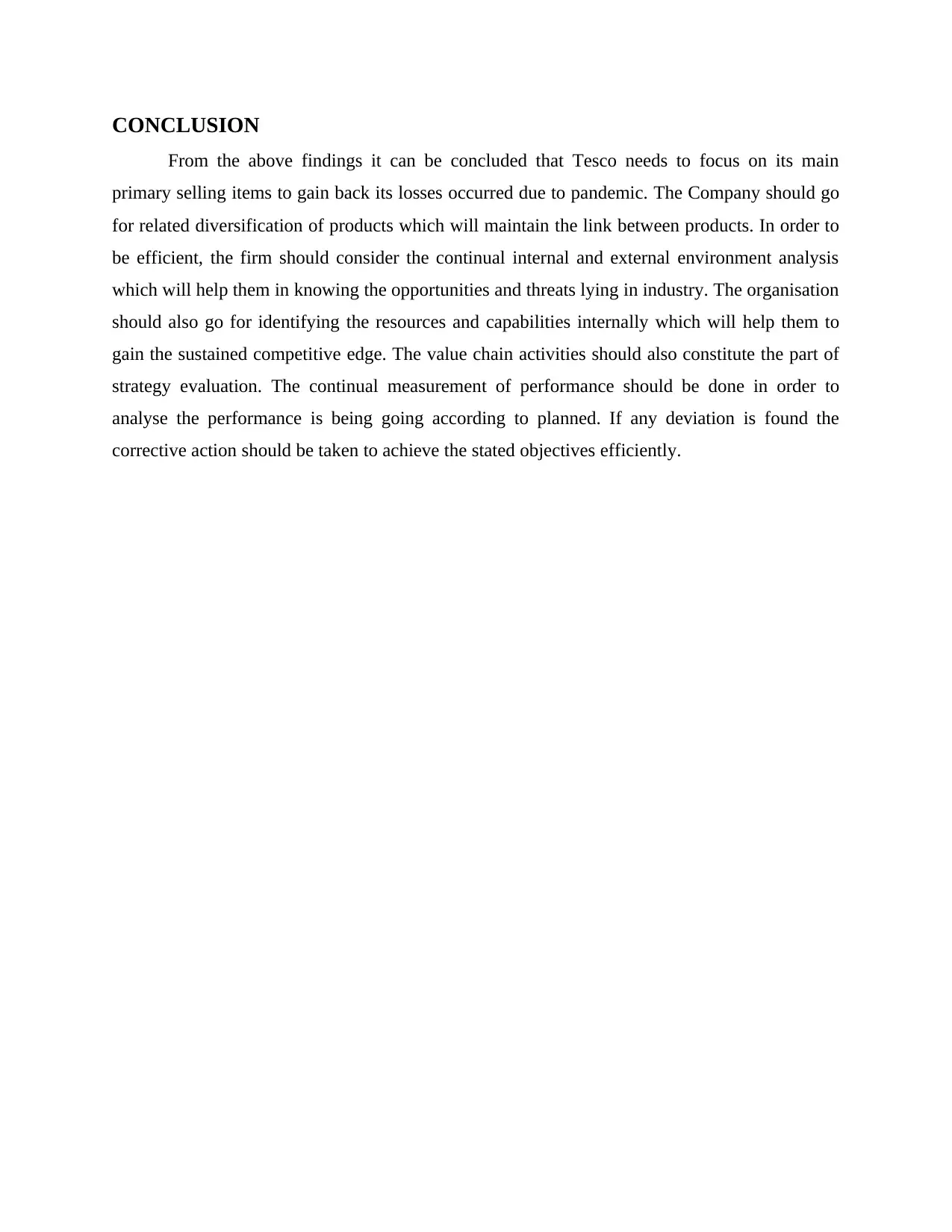
CONCLUSION
From the above findings it can be concluded that Tesco needs to focus on its main
primary selling items to gain back its losses occurred due to pandemic. The Company should go
for related diversification of products which will maintain the link between products. In order to
be efficient, the firm should consider the continual internal and external environment analysis
which will help them in knowing the opportunities and threats lying in industry. The organisation
should also go for identifying the resources and capabilities internally which will help them to
gain the sustained competitive edge. The value chain activities should also constitute the part of
strategy evaluation. The continual measurement of performance should be done in order to
analyse the performance is being going according to planned. If any deviation is found the
corrective action should be taken to achieve the stated objectives efficiently.
From the above findings it can be concluded that Tesco needs to focus on its main
primary selling items to gain back its losses occurred due to pandemic. The Company should go
for related diversification of products which will maintain the link between products. In order to
be efficient, the firm should consider the continual internal and external environment analysis
which will help them in knowing the opportunities and threats lying in industry. The organisation
should also go for identifying the resources and capabilities internally which will help them to
gain the sustained competitive edge. The value chain activities should also constitute the part of
strategy evaluation. The continual measurement of performance should be done in order to
analyse the performance is being going according to planned. If any deviation is found the
corrective action should be taken to achieve the stated objectives efficiently.
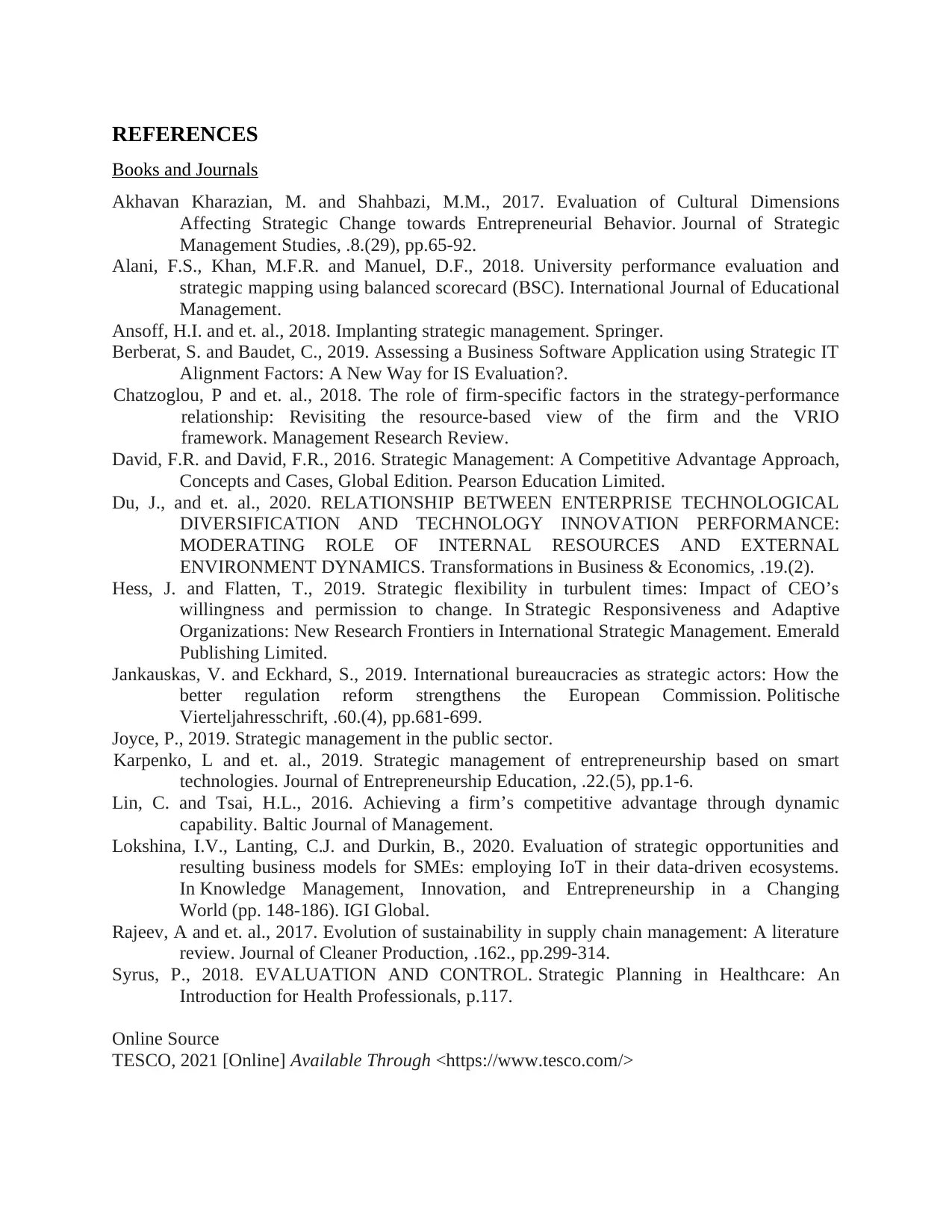
REFERENCES
Books and Journals
Akhavan Kharazian, M. and Shahbazi, M.M., 2017. Evaluation of Cultural Dimensions
Affecting Strategic Change towards Entrepreneurial Behavior. Journal of Strategic
Management Studies, .8.(29), pp.65-92.
Alani, F.S., Khan, M.F.R. and Manuel, D.F., 2018. University performance evaluation and
strategic mapping using balanced scorecard (BSC). International Journal of Educational
Management.
Ansoff, H.I. and et. al., 2018. Implanting strategic management. Springer.
Berberat, S. and Baudet, C., 2019. Assessing a Business Software Application using Strategic IT
Alignment Factors: A New Way for IS Evaluation?.
Chatzoglou, P and et. al., 2018. The role of firm-specific factors in the strategy-performance
relationship: Revisiting the resource-based view of the firm and the VRIO
framework. Management Research Review.
David, F.R. and David, F.R., 2016. Strategic Management: A Competitive Advantage Approach,
Concepts and Cases, Global Edition. Pearson Education Limited.
Du, J., and et. al., 2020. RELATIONSHIP BETWEEN ENTERPRISE TECHNOLOGICAL
DIVERSIFICATION AND TECHNOLOGY INNOVATION PERFORMANCE:
MODERATING ROLE OF INTERNAL RESOURCES AND EXTERNAL
ENVIRONMENT DYNAMICS. Transformations in Business & Economics, .19.(2).
Hess, J. and Flatten, T., 2019. Strategic flexibility in turbulent times: Impact of CEO’s
willingness and permission to change. In Strategic Responsiveness and Adaptive
Organizations: New Research Frontiers in International Strategic Management. Emerald
Publishing Limited.
Jankauskas, V. and Eckhard, S., 2019. International bureaucracies as strategic actors: How the
better regulation reform strengthens the European Commission. Politische
Vierteljahresschrift, .60.(4), pp.681-699.
Joyce, P., 2019. Strategic management in the public sector.
Karpenko, L and et. al., 2019. Strategic management of entrepreneurship based on smart
technologies. Journal of Entrepreneurship Education, .22.(5), pp.1-6.
Lin, C. and Tsai, H.L., 2016. Achieving a firm’s competitive advantage through dynamic
capability. Baltic Journal of Management.
Lokshina, I.V., Lanting, C.J. and Durkin, B., 2020. Evaluation of strategic opportunities and
resulting business models for SMEs: employing IoT in their data-driven ecosystems.
In Knowledge Management, Innovation, and Entrepreneurship in a Changing
World (pp. 148-186). IGI Global.
Rajeev, A and et. al., 2017. Evolution of sustainability in supply chain management: A literature
review. Journal of Cleaner Production, .162., pp.299-314.
Syrus, P., 2018. EVALUATION AND CONTROL. Strategic Planning in Healthcare: An
Introduction for Health Professionals, p.117.
Online Source
TESCO, 2021 [Online] Available Through <https://www.tesco.com/>
Books and Journals
Akhavan Kharazian, M. and Shahbazi, M.M., 2017. Evaluation of Cultural Dimensions
Affecting Strategic Change towards Entrepreneurial Behavior. Journal of Strategic
Management Studies, .8.(29), pp.65-92.
Alani, F.S., Khan, M.F.R. and Manuel, D.F., 2018. University performance evaluation and
strategic mapping using balanced scorecard (BSC). International Journal of Educational
Management.
Ansoff, H.I. and et. al., 2018. Implanting strategic management. Springer.
Berberat, S. and Baudet, C., 2019. Assessing a Business Software Application using Strategic IT
Alignment Factors: A New Way for IS Evaluation?.
Chatzoglou, P and et. al., 2018. The role of firm-specific factors in the strategy-performance
relationship: Revisiting the resource-based view of the firm and the VRIO
framework. Management Research Review.
David, F.R. and David, F.R., 2016. Strategic Management: A Competitive Advantage Approach,
Concepts and Cases, Global Edition. Pearson Education Limited.
Du, J., and et. al., 2020. RELATIONSHIP BETWEEN ENTERPRISE TECHNOLOGICAL
DIVERSIFICATION AND TECHNOLOGY INNOVATION PERFORMANCE:
MODERATING ROLE OF INTERNAL RESOURCES AND EXTERNAL
ENVIRONMENT DYNAMICS. Transformations in Business & Economics, .19.(2).
Hess, J. and Flatten, T., 2019. Strategic flexibility in turbulent times: Impact of CEO’s
willingness and permission to change. In Strategic Responsiveness and Adaptive
Organizations: New Research Frontiers in International Strategic Management. Emerald
Publishing Limited.
Jankauskas, V. and Eckhard, S., 2019. International bureaucracies as strategic actors: How the
better regulation reform strengthens the European Commission. Politische
Vierteljahresschrift, .60.(4), pp.681-699.
Joyce, P., 2019. Strategic management in the public sector.
Karpenko, L and et. al., 2019. Strategic management of entrepreneurship based on smart
technologies. Journal of Entrepreneurship Education, .22.(5), pp.1-6.
Lin, C. and Tsai, H.L., 2016. Achieving a firm’s competitive advantage through dynamic
capability. Baltic Journal of Management.
Lokshina, I.V., Lanting, C.J. and Durkin, B., 2020. Evaluation of strategic opportunities and
resulting business models for SMEs: employing IoT in their data-driven ecosystems.
In Knowledge Management, Innovation, and Entrepreneurship in a Changing
World (pp. 148-186). IGI Global.
Rajeev, A and et. al., 2017. Evolution of sustainability in supply chain management: A literature
review. Journal of Cleaner Production, .162., pp.299-314.
Syrus, P., 2018. EVALUATION AND CONTROL. Strategic Planning in Healthcare: An
Introduction for Health Professionals, p.117.
Online Source
TESCO, 2021 [Online] Available Through <https://www.tesco.com/>
1 out of 13
Related Documents
Your All-in-One AI-Powered Toolkit for Academic Success.
+13062052269
info@desklib.com
Available 24*7 on WhatsApp / Email
![[object Object]](/_next/static/media/star-bottom.7253800d.svg)
Unlock your academic potential
© 2024 | Zucol Services PVT LTD | All rights reserved.





